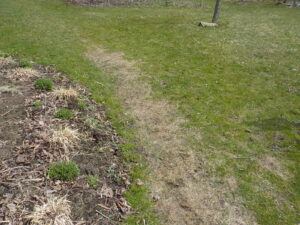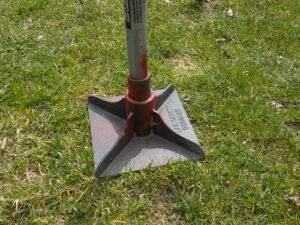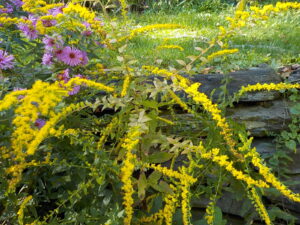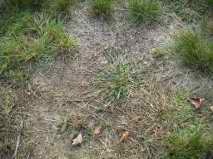Spring Lawn Care
To fix bare spots I use a short-tined garden rake to scuff up the soil. Then I scatter some seed with my hand, just sprinkling it over the spot. Next I sprinkle a thin layer of compost or fine garden soil over the seed. Not too much: most grasses need sunshine on the seed to germinate. Bury it with an inch of soil, and it won’t do well. Finally, pat it down with your foot, lightly, or with a metal tamper.
Let’s re-think the concept of a lawn. Why do we need a large patch of short grass at an even height all around our house? Sure, people with kids and dogs need some place to play ball or Frisbee. And if you like to have friends over and sit around a barbecue grill, a little lawn is nice. But do you really like mowing an acre of lawn once a week, or paying someone else to do it? Maybe it’s time to reduce the size of your lawn and plant some more native trees and shrubs.
In addition to the oaks, native cherry and willow trees, other “keystone” trees include birches, poplars (he calls them cottonwoods) and elm. He said just 5% of the genera of plants support 75% of the caterpillars. Great perennials include goldenrod (the absolute best), asters, and members of the sunflower family. There are many tame goldenrod species that will not take over your garden, so expand your plant palette to include “Fireworks” goldenrod and other nice varieties.
When you add grass seed to fill in spots, I recommend a mix of seeds, not a pure Kentucky bluegrass, which is the neediest of all grasses. It needs fertilizer, and watering. A “Conservation Mix” will do better for you. And if you are planting in a shady area, get a mix made for shady places. Those sun/shade mixes are not as good for shady areas as those designed for them.
Fall Lawn Care
I love a little bit of lawn. It sets off the flowers, walkways, stones, shrubs and trees of my garden. I think it looks good, even though it has weeds and dandelions mixed in and has a few thin spots. I should get busy now and do a little lawn care – and you might want to work on yours, too.
For starters, this is the time to plant seed. Fall is much better than spring, as the soil is warm and the seed will germinate more easily. Not only that, annual weeds and crabgrass are less interested in germinating now – they seem to know that winter is coming, along with the cold weather that will kill them. As an added bonus, the fall is generally rainy so you won’t have to water your new lawn very often.
To develop a thicker, richer lawn, you can overseed the thin parts by spreading some seeds over existing lawn. Just loosen the soil surface a little with a short-tined rake and scatter seed over places that need it. Then spread a thin layer of compost over the seed. If you have some empty spots, do this: plant seed, add compost, and then cover the area with a thin layer of straw or hay to shade the soil and prevent it from drying out.
Don’t buy pure Kentucky bluegrass, thinking you will get a premium lawn. Get a good mixture of grasses. The color and texture of bluegrass is preferred by some people, but it requires full sun and more fertilizer than other grasses. Furthermore, any monoculture – such as a pure stand of bluegrass – is more susceptible to attacks by insects and diseases. And don’t get the cheapest seed you can find. Good quality grass seed costs more, but does better.
For a lawn that requires the least fertilizing and mowing, choose a mix that is about 80% tall fescue and only 20% Kentucky bluegrass. Fescue is not as fine as bluegrass, but it is deep rooted and will survive drought and high foot traffic. Few pests will bother it. Ten percent Dutch white clover in the mix will add nitrogen naturally – so long as you add no herbicides, which will kill clover. This lawn will do okay even without adding fertilizers.
Don’t expect to be able to plant just one type of grass seed everywhere on your property. If you have shade, buy a shade mix that has about 70% fine fescue, 20% perennial ryegrass, with perhaps 10% Kentucky bluegrass of a shade-tolerant variety.
I know that the “Weed-n-Feed” companies sell bags of stuff to promote good growth while keeping out weeds. You can have a better lawn, in my opinion, by spreading a little compost over your lawn each year. Just fling fine compost with a shovel and then spread it out with a rake – a quarter to a half an inch is plenty. Weeds? Keep the blades on the lawnmower at around 3 inches to help shade out weeds when they start up. But cut the lawn a little shorter the last 2 mowings before winter – that will reduce the chance of mold or mildew developing during wet times.
Acid rain is a reality here in New England, so unless you add limestone, the soil in your lawn will eventually get to the point where weeds thrive better than grass. You can get your soil pH tested through your state’s Extension Service or buy a kit at the garden center. The test will tell you how many pounds of limestone per thousand square feet of lawn – so brush up on your math skills.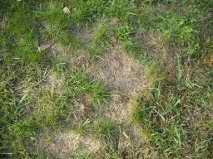
Limestone is very slow to move through the soil, and adding it in the fall gives it time to work. If you can scratch limestone into the lawn with a rake and get it below the surface a little, it will be closer to the crown, or growing point, for both roots and leaves. For new lawns, lightly rototill in limestone and compost in the top four inches of soil before seeding. Limestone provides calcium and keeps the soil from getting too acidic. If you buy “dolmitic” limestone it provides magnesium as well as calcium. “Calcitic” limestone does not have magnesium – a soil test will tell you whether you need magnesium or not.
I always use the mulcher attachment on my lawn mower in the fall to chop up the leaves. The attachment blocks the exit where the mower would normally spit out the clippings, so it chops everything more finely. I do rake up the bulk of the leaves, but the smallest bits stay on the lawn, adding organic matter and feeding the microorganisms in the soil – and making a healthier lawn.
Your lawnmower and other gas-powered equipment need a little tender loving care at the end of the season, too. It is a good idea to add stabilizer to the gas you use so that it won’t lose its zing over the winter, or foul the carburetor. The brand recommended to me by my local mechanic, Claude, is called Sta-Bil. Claude also recommends adding something to counteract the effects of ethanol in gas all season long – I recently bought a small bottle of “Quickshot” gasoline treatment said to “fight ethanol problems”.
Years ago I bought a couple of sheep to mow my lawn, and found that they were difficult to manage. I borrowed a portable electric fence to keep them out of the gardens, but they still managed to eat some flowers and inexplicably left parts of the lawn uneaten. Oh well, they did provide free fertilizer – and eventually lamb chops. Any way you look at it, a nice lawn takes some work.
Henry Homeyer can be reached at P.O. Box 364, Cornish Flat, NH 03746 or at henry.homeyer@comcast.net. His new book is called Organic Gardening (not just) in the Northeast, a Hands-On, Month-by-Month Guide.



